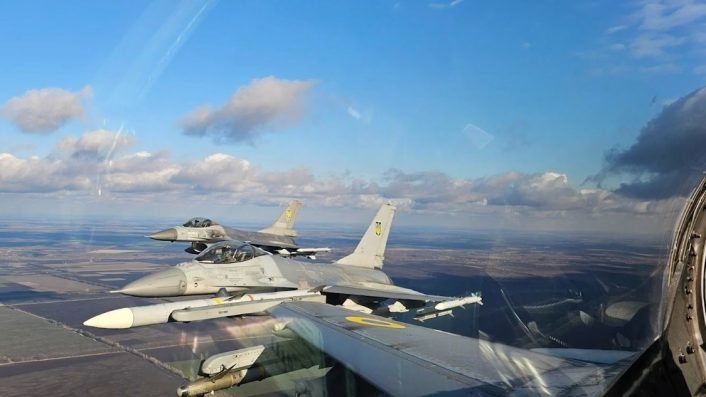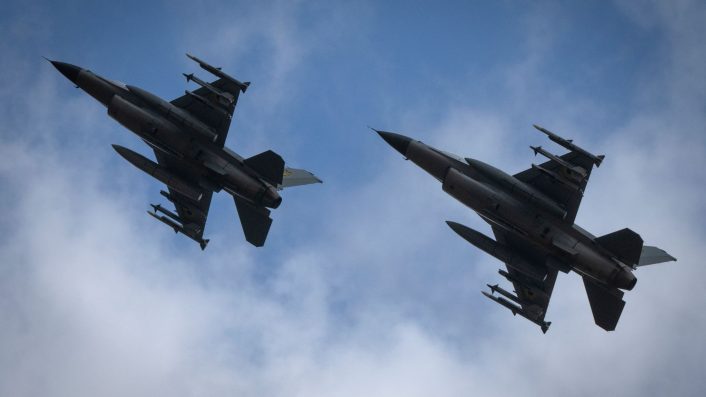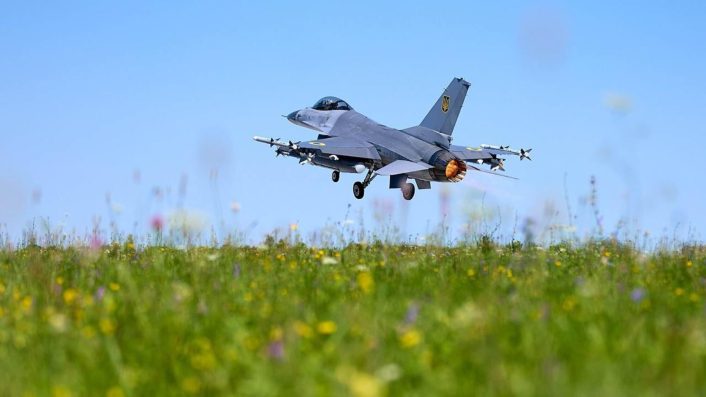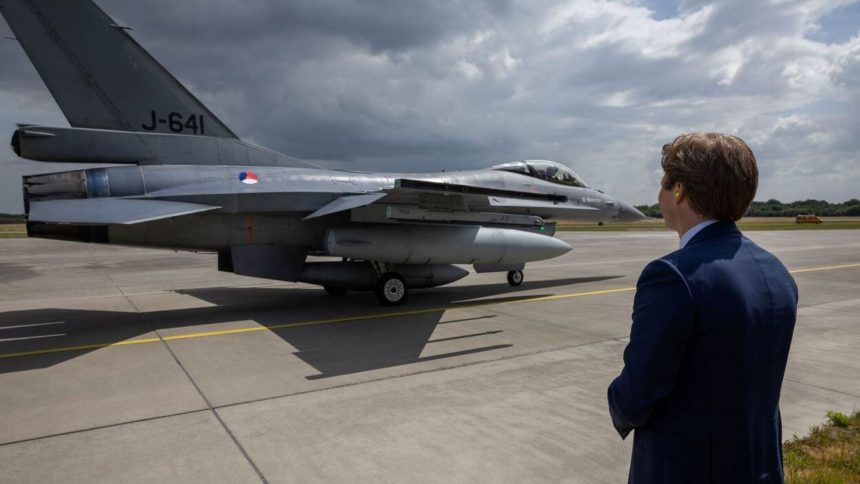Less than a year after the first deliveries, the RNLAF completed the transfer of the last of the 24 F-16s promised to Ukraine, which will reach the country after a stop in Belgium.
The Netherlands’ Defence Minister Ruben Brekelmans revealed in the Dutch talk show WNL op Zondag on May 25, 2025, that the country would complete its delivery of 24 F-16 to Ukraine the following day, without revealing the mode and location of the transfer to guard against Russian standoff strikes. “Tomorrow, we will see the last F-16 leave the Netherlands […] and that means we have the 24 that we have committed to and they will be operational in Ukraine very soon,” Brekelmans said.
The Dutch Ministry of Defense (MoD) thereafter issued a press release on May 26, showing photographs of Brekelmans at the Koninklijke Luchtmacht’s Volkel Air Base, waiving off the last of the F-16s before they flew to Belgium. Once there, they will be prepared for the onward journey to Ukraine and their introduction in the Ukrainian Air Force.
NATO fighters up. Six F-16s (Belgian and RNLAF), Thirteen Luftwaffe, including six out of Norvenich and three out of Neuberg (both Eurofighter bases). These are training flights. pic.twitter.com/jf8iZ1alW8
— Evergreen Intel (@vcdgf555) May 26, 2025
Brekelmans’s revelation was in response to a question by the host about the efforts to guard Kyiv as Russia conducted one of its largest standoff strikes in the capital, with some 250 drones and 14 ballistic missiles. NPR put the figure at 367 drones and missiles, and quoted Ukrainian Air Force spokesperson Yuriy Inhat who called it the single largest attack in the three-year-long war.
“Because of the daily Russian air strikes, the F-16s are of vital importance to Ukraine. It enables them to keep Russian aggression at bay for us too,” Brekelmans said in the statement.
De laatste 🇳🇱 F-16’s die bestemd zijn voor Oekraïne, hebben Nederland verlaten. Ze zijn vandaag van @VlbVolkel naar België vertrokken, waar ze worden voorbereid voor de levering. In totaal heeft NL daarmee 24 F-16’s aan Oekraïne gedoneerd.
Lees meer 👇 https://t.co/GxvYQiPW2h
— Koninklijke Luchtmacht (@Kon_Luchtmacht) May 26, 2025
Ukraine received in July 2024 its first batch of F-16s, a month after the United States, the Netherlands and Denmark released a joint statement revealing that the transfer of the F-16s was underway and that they would be operational by this summer of that year. According to Ukrainska Pravda, Ukraine received the first batch of Dutch F-16s in Oct. 2024, while the second delivery was completed in Feb. 2025, as announced by President Volodymyr Zelenskyy.
The release added that the Dutch involvement in Ukraine’s F-16 program is “far from over,” as “together with Denmark and the United States, the Netherlands leads the international F-16 coalition,” continuing to “provide the total package of support to keep the F-16s in the air,” including “training, spare parts, ammunition and fuel.”

Ukraine’s F-16s
Netherlands and Denmark originally led the effort to supply F-16s to Ukraine in Aug. 2023, and training programs for Ukrainian pilots were set up in Denmark, U.K., U.S. and Romania. The European F-16 Training Center (EFTC) at Baza 86 Aeriana Fetesti, in Romania, is the most advanced effort, with even instructors from Lockheed Martin said to be involved. Denmark in particular has been looking to divest its older F-16 jets and replace them with F-35As.
In May 2024, Belgium announced transferring 30 F-16AM fighters to Ukraine in a €977 million military aid package. Beside the 30 aircraft from Belgium and 24 from the Netherlands, 19 F-16s from Denmark and 12 from Norway are also expected, which took the number of F-16s expected to be delivered to Kyiv to 85, from the initial 55, as reported by The Aviationist.
The Netherlands will send its final batch of the 24 F-16 “Fighting Falcons” initially pledged to Ukraine on May 26th, according to Dutch Defense Minister Ruben Brekelmans. Besides the F-16s provided by the Netherlands, Ukraine has also been promised 19 F-16s from Denmark, 30 from… pic.twitter.com/09QoWsMlJX
— OSINTdefender (@sentdefender) May 26, 2025
The operations of Ukrainian F-16s have however not been without their share of losses, with President Volodymyr Zelenskyy announcing the death of Capt. Pavlo Ivanov on Apr. 12, 2025, during a combat mission, which suggested that the F-16 airframe was also lost. Prior to that, on Aug. 26, 2024, the loss of a Ukrainian F-16 in a crash marked the first loss of the Fighting Falcon in Ukraine in the course of the war with Russia, confirmed by U.S. officials to the Wall Street Journal.
The Netherlands will send its final batch of F-16 Fighting Falcons to Ukraine this week, completing Europe’s first sprint of 24 F-16s delivered to the Ukrainian Air Force.
Ukraine’s Falcon fleet should eventually reach roughly 80 airframes in the coming years. pic.twitter.com/MhgrtYwirb
— OSINTtechnical (@Osinttechnical) May 25, 2025
The crash is believed to have been the result of pilot error and not enemy fire. Around the time of this crash, U.S. officials had put the number of F-16s delivered to and operated by Ukraine at six. A majority of these F-16s, both in the single-seat AM and twin-seat BM variants, are former Dutch F-16s.
Late in April 2025, the U.S. made its first material contribution to the F-16 effort for Ukraine, when images of partially disassembled F-16s being loaded onto a Ukrainian charter Antonov An-124 transport aircraft at Arizona emerged.

A U.S. Air Force spokesperson confirmed to the The War Zone that the service was “providing disused and completely non-operational F-16s to Ukraine for parts.” The aircraft come from the ‘Boneyard’ at Davis-Monthan AFB in Arizona, and the jets, without engine, radar and many other components, were “not flyable […] and could not be reconstituted for operational use.”
That An-124 landed at Tucson airport on Apr. 25 and, after loading the dismantled F-16s, took off on Apr. 26 for Rzeszów-Jasionka Airport in southeastern Poland – a vital transit hub for Western-supplied military equipment meant for Ukraine.
While confirming the details of this, I found further pictures posted online by a local transportation company showing a third wrapped F-16 at Davis-Monthan and being loaded into the Antonov An-124. pic.twitter.com/xKCTAPxX03
— Keystone Intel (@KSOSINT) April 29, 2025
Future of Ukrainian F-16s
In the overnight strike on May 25, Russia used 69 missiles of various types and 298 drones, including Iranian-designed Shahed drones, Inhat told The Associated Press. Russian Kh-101 ALCM and Iskander tactical ballistic missile strikes on Ukrainian bases had also forced the UAF to increasingly operate its jets from dispersed and non-traditional airfields and runways, and is believed to be constantly rotating its F-16s from various locations in unpredictable patterns of take-offs and landings.
❗️The 🇳🇱Netherlands will send the last of the 24 F-16 fighter jets promised to 🇺🇦Ukraine tomorrow, – PAP
This was stated by the Minister of Defense of the Netherlands, Ruben Brekelmans, on Dutch television. pic.twitter.com/X7p2zQ6LfO
— 🪖MilitaryNewsUA🇺🇦 (@front_ukrainian) May 25, 2025
Western F-16s are definitely a significant improvement over Ukraine’s Russian-origin MiG-29s, Su-27s, Su-24 Fencers and Su-25 Frogfoot ground attack jets, primarily because they are more compatible with NATO weapons. These weapons, like the AGM-88 HARM (High-Speed Anti-Radiation Missile), GBU-39 SDB (Small Diameter Bomb) glide bomb had been integrated on the UAF’s Su-27 and MiG-29s and faced possibly limited performance owing to the tweaked software and adapted hardware.
Low pass by a Ukrainian Air Force F-16AM Fighting Falcon on a strike mission.
Armed with 8x GBU-39 SDB glide bombs, 1x AIM-9X Sidewinder, 1x AIM-9L Sidewinder, and 2x AIM-120C AMRAAMs. pic.twitter.com/0Hd45fzUIQ
— OSINTtechnical (@Osinttechnical) February 16, 2025
On the other hand, the organic interface compatibility with the Western F-16s allows optimum performance. This aspect was shown in a video that emerged in mid-February this year of a Ukrainian F-16 Viper armed with eight GBU-39 SDBs, along with a mix of AIM-120C AMRAAM, AIM-9L/M, AIM-9X Sidewinder air-to-air missiles, two 370 gallons external fuel tanks and an ALQ-131 Electronic Counter Measures pod.

Other Western weapons in Ukraine include the Joint Direct Attack Munition (JDAM), ADM-160 MALD (Miniature Air-Launched Decoy) and the Storm Shadow/SCALP-EG ALCM (Air-Launched Cruise Missile). The latter, however, can’t be used by the F-16, while the others have not yet been sighted on Ukrainian F-16s.
Brekelmans noted Ukrainian pilots’ and technicians’ transitioned from their older aircraft to the F-16 “in record time,” and “the Dutch side […] also worked incredibly hard” to make it happen. “The F-16s have a better overview of the battlefield and a higher chance of survival than the outdated Soviet aircraft that the Ukrainian air force flew,” Brekelmans further stated.









